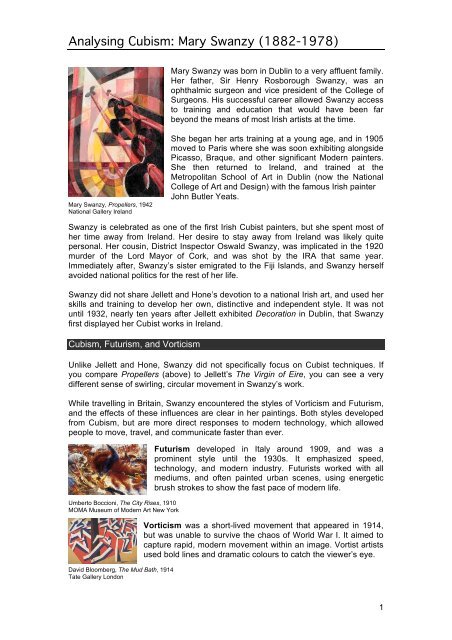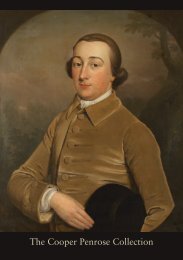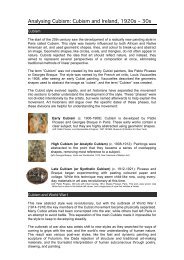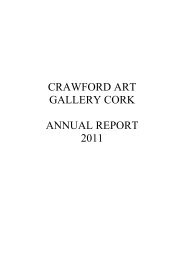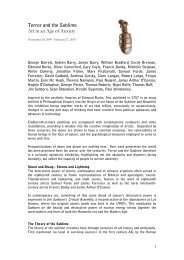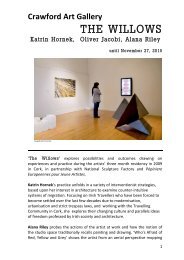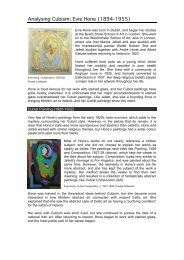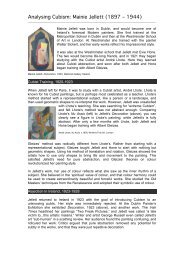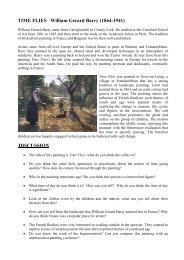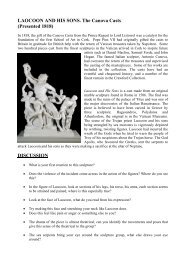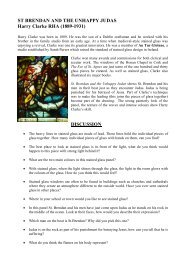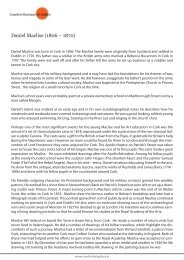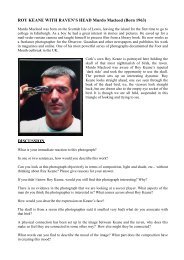Analysing Cubism: Mary Swanzy (1882-1978) - Crawford Art Gallery
Analysing Cubism: Mary Swanzy (1882-1978) - Crawford Art Gallery
Analysing Cubism: Mary Swanzy (1882-1978) - Crawford Art Gallery
You also want an ePaper? Increase the reach of your titles
YUMPU automatically turns print PDFs into web optimized ePapers that Google loves.
<strong>Analysing</strong> <strong>Cubism</strong>: <strong>Mary</strong> <strong>Swanzy</strong> (<strong>1882</strong>-<strong>1978</strong>)<br />
<strong>Mary</strong> <strong>Swanzy</strong> was born in Dublin to a very affluent family.<br />
Her father, Sir Henry Rosborough <strong>Swanzy</strong>, was an<br />
ophthalmic surgeon and vice president of the College of<br />
Surgeons. His successful career allowed <strong>Swanzy</strong> access<br />
to training and education that would have been far<br />
beyond the means of most Irish artists at the time.<br />
<strong>Mary</strong> <strong>Swanzy</strong>, Propellers, 1942<br />
National <strong>Gallery</strong> Ireland<br />
She began her arts training at a young age, and in 1905<br />
moved to Paris where she was soon exhibiting alongside<br />
Picasso, Braque, and other significant Modern painters.<br />
She then returned to Ireland, and trained at the<br />
Metropolitan School of <strong>Art</strong> in Dublin (now the National<br />
College of <strong>Art</strong> and Design) with the famous Irish painter<br />
John Butler Yeats.<br />
<strong>Swanzy</strong> is celebrated as one of the first Irish Cubist painters, but she spent most of<br />
her time away from Ireland. Her desire to stay away from Ireland was likely quite<br />
personal. Her cousin, District Inspector Oswald <strong>Swanzy</strong>, was implicated in the 1920<br />
murder of the Lord Mayor of Cork, and was shot by the IRA that same year.<br />
Immediately after, <strong>Swanzy</strong>’s sister emigrated to the Fiji Islands, and <strong>Swanzy</strong> herself<br />
avoided national politics for the rest of her life.<br />
<strong>Swanzy</strong> did not share Jellett and Hone’s devotion to a national Irish art, and used her<br />
skills and training to develop her own, distinctive and independent style. It was not<br />
until 1932, nearly ten years after Jellett exhibited Decoration in Dublin, that <strong>Swanzy</strong><br />
first displayed her Cubist works in Ireland.<br />
<strong>Cubism</strong>, Futurism, and Vorticism<br />
Unlike Jellett and Hone, <strong>Swanzy</strong> did not specifically focus on Cubist techniques. If<br />
you compare Propellers (above) to Jellett’s The Virgin of Eire, you can see a very<br />
different sense of swirling, circular movement in <strong>Swanzy</strong>’s work.<br />
While travelling in Britain, <strong>Swanzy</strong> encountered the styles of Vorticism and Futurism,<br />
and the effects of these influences are clear in her paintings. Both styles developed<br />
from <strong>Cubism</strong>, but are more direct responses to modern technology, which allowed<br />
people to move, travel, and communicate faster than ever.<br />
Umberto Boccioni, The City Rises, 1910<br />
MOMA Museum of Modern <strong>Art</strong> New York<br />
David Bloomberg, The Mud Bath, 1914<br />
Tate <strong>Gallery</strong> London<br />
Futurism developed in Italy around 1909, and was a<br />
prominent style until the 1930s. It emphasized speed,<br />
technology, and modern industry. Futurists worked with all<br />
mediums, and often painted urban scenes, using energetic<br />
brush strokes to show the fast pace of modern life.<br />
Vorticism was a short-lived movement that appeared in 1914,<br />
but was unable to survive the chaos of World War I. It aimed to<br />
capture rapid, modern movement within an image. Vortist artists<br />
used bold lines and dramatic colours to catch the viewer’s eye.<br />
1
Personal Style<br />
<strong>Mary</strong> <strong>Swanzy</strong>’s parents passed away just before World War I, and left her with an<br />
inheritance that would sustain her for the rest of her life. She was able to finance her<br />
art without sponsorship or the sale of her works. This granted her significant artistic<br />
freedom, and not only could she train and travel extensively, but she did not have to<br />
adjust her style to suit patrons or commissioned work.<br />
It is nearly impossible to determine exactly<br />
how <strong>Swanzy</strong> developed her style, because<br />
she rarely dated her paintings. However, her<br />
use of repeating, swirling patterns and rich<br />
colours was a common theme in her Cubist<br />
paintings from at least the 1920s onward.<br />
She was a dedicated Modernist, and used<br />
all of the tools at her disposal to create new,<br />
abstract works. She incorporated elements<br />
<strong>Mary</strong> <strong>Swanzy</strong>, Canal Embankment, 1920s from Gleizes’ early Cubist abstraction<br />
Private Collection<br />
techniques with implied Futurist movement<br />
to create increasingly fantastic paintings.<br />
She often painted landscapes, but not of the traditionally<br />
Irish sort. Her landscapes were inspired by her travels<br />
through the Pacific, and are full of lush vegetation, warm<br />
colours, and bright flowers. This combination of manmade<br />
structures and nature allowed her to explore the<br />
rigid buildings compared to more circular and fluid<br />
natural elements. A perfect example of this is Oil<br />
painting à la mode d’André Lhote (left), where a square,<br />
urban background is overlapped by the heavy green<br />
plants in the foreground.<br />
<strong>Swanzy</strong>’s works do not rely purely on Albert Gleizes’<br />
theory on <strong>Cubism</strong>, but her combination of Cubist<br />
abstraction, Futurist forms, and romantic landscapes<br />
created a Modern style of painting that became<br />
dynamic in its own right.<br />
<strong>Mary</strong> <strong>Swanzy</strong>, Oil painting à la<br />
mode d’André Lhote, undated<br />
Highlanes <strong>Gallery</strong>, Drogheda<br />
<strong>Mary</strong> <strong>Swanzy</strong>, The Mêlée, c. 1945<br />
Private Collection<br />
<br />
<strong>Mary</strong> <strong>Swanzy</strong> had an exceptionally long artistic<br />
career. All of her works show a clear connection<br />
with the developments of the various Modern <strong>Art</strong><br />
movements. She pursued Modern <strong>Art</strong> beyond<br />
<strong>Cubism</strong>, and between the 1930s-40s she became<br />
increasingly influenced by Surrealism. With this<br />
new influence, a new chapter in her work was<br />
born, and her swirling, Cubist landscapes were<br />
replaced by contorted human figures and bizarre<br />
rural and urban scenes.<br />
2


